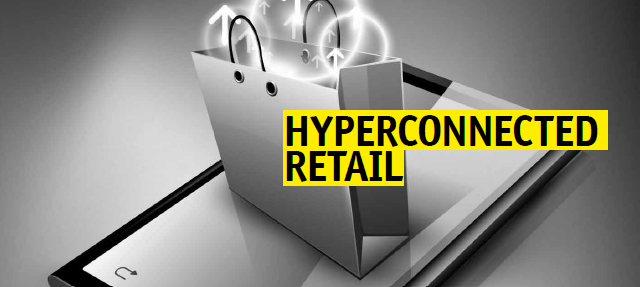The first thing a customer arriving on a retailer’s website for the very first time looks for is some reassurance that the company can be trusted to provide high-quality products or services.
What better way to provide this reassurance than with the testimony of existing customers, says Nick Wheeler, founder and chief executive of Charles Tyrwhitt, the men’s apparel retailer.
“New customers don’t know how good we are,” Mr Wheeler says. “But if they can see how 50,000 people have rated us, or the feedback someone left two minutes ago, it feels authentic and is great for customer confidence.”
Surfacing customer feedback on the site is one way in which Charles Tyrwhitt is exploiting hyperconnectivity – the exponential growth in the flow of information between people, places and things – for commercial gain. “A danger for business is that the voice of the consumer has become louder, for example, through social media,” Mr Wheeler says. “You need to embrace that openness and respond, as we do with our online reviews.”
Hyperconnectivity is having an impact across all aspects of retail, eroding the position of established players and creating huge opportunities for start-ups. It is transforming sales channels and disrupting the whole supply chain, according to Susan Anderson, analyst vice-president at FBR Capital Markets & Co.
There is pressure on the margins of retailers that cannot compress their supply chains and new product cycles through hyperconnectivity. “This has already led to many closures,” says Ms Anderson, “at stores such as Aeropostale, Abercrombie & Fitch and American Eagle Outfitters.”
It is tougher for the established players than the new ones, because they have more to lose. Many are locked into multi-year leases that are expensive to break, explains Ms Anderson. “So unless bricks-and-mortar retailers are desperate, they are hoping to wait until their leases expire.”
"Digital is not simply a new sales channel but also a platform for a more harmonised shopping experience"
Meanwhile, it’s pretty easy to open an online shop and start selling products, she says. This is increasing competition, particularly in the teen space, where many players are selling at lower prices because they don’t have the fixed costs of stores.
Among 30 new online companies identified by Ms Anderson as threatening established players are Brandy Melville, ModCloth and UrbanOG in the US, and boohoo in the UK. “Bigger online players, such as the UK’s ASOS and Gilt in the US, are more threatening to high street stores,” she says. “But the smaller players add up too.”
A similar story is unfolding in Japan, Ms Anderson says, but in China the situation is rather different. “China started differently because retailers there didn’t build out a massive store base. They only started expanding once e-commerce was already established, and a lot of them even began online.”
Brian Kilcourse, managing partner at US-based Retail Systems Research (RSR), says it is wrong to think that exploiting hyperconnectivity is all about selling online. In the US, 92% of sales still happen at stores, according to Mr Kilcourse.
Digital is not simply a new sales channel but also a platform for a more harmonised shopping experience, he says. This is well understood by the sector’s “over-performers”, according to research he conducted in August. It showed that three times as many retail over-performers as underperformers believe the main purpose of digital selling strategies is to drive traffic to stores.
“It’s important for retailers to recognise that consumers still go to stores to take possession of goods,” Mr Kilcourse says. In the UK, this has been demonstrated with the success of “click and collect” services from retailers such as Marks & Spencer and John Lewis.
Omnichannel customers are more profitable than those who only use stores, according to RSR’s research. ”People who use all channels are definitely better,” Mr Kilcourse says. Traditional stores should follow the example of women’s apparel retailer Chico’s, Ms Anderson says, which lets customers pick clothes online and have them waiting in the dressing room at their local store when they visit.
Artificial shoppers
According to Greg Girard, programme director for IDC Retail Insights, the big opportunity in hyperconnectivity for retailers is “participatory commerce”. This refers to the use of artificially intelligent agents, or “bots”, which negotiate online on behalf of shoppers, retailers and brands. A shopping bot can learn an individual’s preferences for particular brands, pack sizes and store locations. Consumers might give it “rules”, such as “I prefer organic, low salt, non-GMO”, or it might just notice that someone tends to choose such products.
ShoppingScout, a shopping bot from California-based start-up Engage3, has thousands of users and knows everything they have bought, Mr Girard says. “Future bots will be more versatile, for example, taking into account your whereabouts, identifying the best local store for your groceries and arranging a convenient delivery time.”
A retailer’s bot, meanwhile, would seek to sell excess inventory or make attractive offers to high-value customers, while a brand’s bot would look for maximised return on promotions. “Brands currently waste hundreds of millions of dollars on promotions that deliver very low return on investment,” Mr Girard says.
Connecting customer insight to product intelligence – knowledge of a product’s attributes – will enable pricing and promotions matched to an individual consumer’s willingness to pay. Airlines, hotels and car rental companies have used this approach, known as discriminatory pricing, for almost two decades, says Mr Girard. “In future it will become the norm in hyperconnected retail.”
So far, retail forecasting has been based on history, says Mr Girard, but the growing amount of information available means retailers can be more predictive. “Hyperconnectivity enables retailers to know shoppers’ intentions to buy.”
One way to explore buying intentions is through online “communities”, which brands such as P&G’s Pampers have already established for shoppers.
These create an emotional attachment, so the product ceases to be a commodity. By analysing what shoppers do in communities such as pampers.com, brands and retailers find out what’s relevant to shoppers. This helps create a triple win, says Mr Girard. “Better returns on promotional spending for brands, more profitable sales for retailers, and greater satisfaction with goods bought for shoppers.
Shoppers are also being encouraged to create electronic shopping lists or sign up for “games” to earn points and awards. “I might want to become a ‘gold star’ Fairtrade shopper,” says Mr Girard. “And I might take pride in this award, displaying it on Facebook, or Pinterest, or tweeting it.”
Charles Tyrwhitt’s Mr Wheeler is keen to use hyperconnectivity to work more closely with suppliers and to get to know customers better. But he sees a risk in alienating people with too much technology.
“Software that lets you send offers to their mobile phones as they pass the store are all very well if you are the first to do this, but if lots of other shops are doing it too, you’re going to drive customers nuts,” he says. “They don’t want ten promotional texts as they walk down the street.”
There is always a danger in being at the cutting edge in technology, says Mr Wheeler. “You end up bleeding, especially if you invest in technology that isn’t widely adopted.” Technology in retail does not have to be complex, he says, although technologists will always try to make it hard for normal managers to understand. “You have to be doing it for the right reasons, that is, as a shopkeeper focused on quality, value and service.”
Click here to download this article as a PDF








